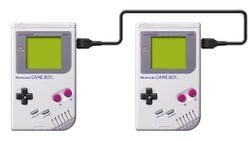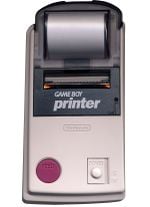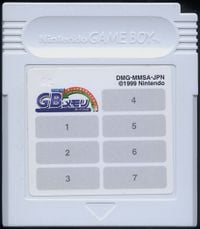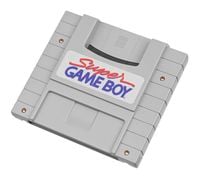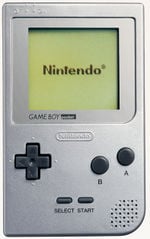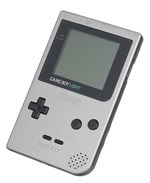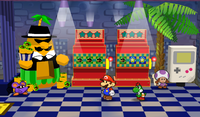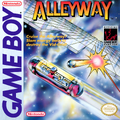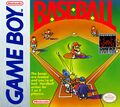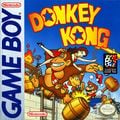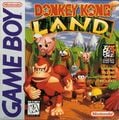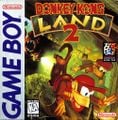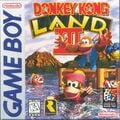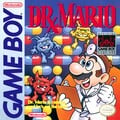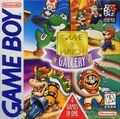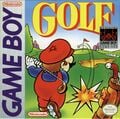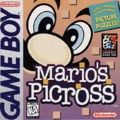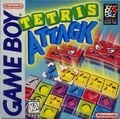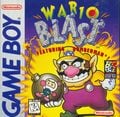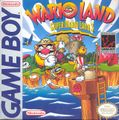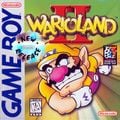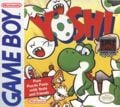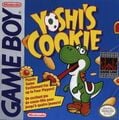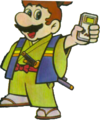Game Boy: Difference between revisions
m (Text replacement - "{{[Cc]onsoles}}" to "{{Systems}}") |
|||
| (35 intermediate revisions by 15 users not shown) | |||
| Line 3: | Line 3: | ||
|image=[[File:Gameboy.jpg|250px]] | |image=[[File:Gameboy.jpg|250px]] | ||
|generation=Fourth | |generation=Fourth | ||
|release={{ | |release={{flag list|Japan|April 21, 1989|USA|July 31, 1989|Europe|September 28, 1990|Hungary|1991<ref name=Rogers_2020>{{cite|author=Joshua Rogers|date=December 26, 2020|url=https://www.youtube.com/watch?v=q75Re7deJC0|publisher=PAX (via YouTube)|title=World of Nintendo: Exploring Nintendo in (Eastern) Europe|language=English|archive=https://web.archive.org/web/20240605201614/https://www.youtube.com/watch?v=q75Re7deJC0|accessdate=June 5, 2024}}</ref>|South Korea|May 2, 1991<ref>{{cite|url=www.thisisgame.com/webzine/nboard/212/?n=54483|title=[좌충우돌] 4월 21일 - 게임보이, 세상에 나오다|language=Korean|publisher=This is Game|accessdate=April 22, 2024}}</ref>|South Africa (1928-1994)|1992<ref>{{cite|author=Rogers, Joshua Alexander|date=April 16, 2020|url=www.linkedin.com/pulse/video-games-around-world-south-africa-joshua-rogers/|title=Video Games around the World|publisher=LinkedIn|archive=web.archive.org/web/20220925153658/https://www.linkedin.com/pulse/video-games-around-world-south-africa-joshua-rogers}}</ref>|Croatia|1994<ref name=Rogers_2020/>|Czech Republic|1994<ref name=Rogers_2020/>|FR Yugoslavia|1994<ref name=Rogers_2020/>|Slovakia|1994<ref name=Rogers_2020/>|Slovenia|1994<ref name=Rogers_2020/>|Poland|November 14, 1994<ref name=Rogers_2020/>}} | ||
|discontinued=2003<ref> | |discontinued=2003<ref>{{cite|format=PDF|url=www.nintendo.co.jp/ir/library/historical_data/pdf/consolidated_sales_e1603.pdf|title=Consolidated Sales Transition by Region|publisher=Nintendo.com|accessdate=March 5, 2020}}</ref> | ||
|predecessor=[[Game & Watch]] | |predecessor=[[Game & Watch]] | ||
|successor=[[Virtual Boy]]<br>[[Game Boy Color]] | |successor=[[Virtual Boy]]<br>[[Game Boy Color]] | ||
}} | }} | ||
{{ | {{quote|Now you're playing with power. Portable power.|The Game Boy slogan}} | ||
[[File:Game Boy logo.svg|left|230px|class=invert]] | [[File:Game Boy logo.svg|left|230px|class=invert-dark]] | ||
The '''{{wp|Game Boy}}''' (rebranded the {{wp|SK Hynix|Hyundai}} Mini Comboy in South Korea) is [[Nintendo]]'s second handheld console. The Game Boy is one of the best selling game systems of all time, | The '''{{wp|Game Boy}}''' (rebranded the '''{{wp|SK Hynix|Hyundai}} Mini Comboy''' in South Korea) is [[Nintendo]]'s second handheld console. It was released in Japan on April 21, 1989; in North America on July 31, 1989; in most of Europe on September 28, 1990; in Hungary in 1991; in South Korea on May 2, 1991; in South Africa in 1992; in Croatia, the Czech Republic, Slovakia, Slovenia, and Yugoslavia in 1994; and in Poland on November 14, 1994 (the latter simultaneously with the [[Nintendo Entertainment System]] and [[Super Nintendo Entertainment System]]).<ref name=Rogers_2020/> It has had many games of the [[Super Mario (franchise)|''Super Mario'' franchise]] released for it and many appearances in the franchise itself. The Game Boy is one of the best-selling game systems of all time, selling around 64,420,000 units worldwide, and the console found enough success not to receive a successor until the [[Game Boy Color]] in 1998, and not to be discontinued until 2003. The Game Boy has 8-bit graphics, not unlike the Nintendo Entertainment System, but can display only up to four colors at once. Its codename is the Dot Matrix Game, referring to the dot-matrix display it had for its games, contrasting the preceding [[Game & Watch]]'s pre-printed LCD display. The Game Boy has the {{button|gb|A}}, {{button|gb|B}}, {{button|gb|start}}, and {{button|gb|select}} buttons as well as {{button|gb|Pad}}, giving it a similar control scheme to the Nintendo Entertainment System's. | ||
In 1995, a new version of the Game Boy, as part of Nintendo's "Play It Loud!" campaign, was released. This version is exactly the same as the original; the only difference is that it was released in a wide variety of colors such as red, blue, green, and even clear. Game Boy and Game Boy Color games were also available on the [[Nintendo 3DS]] [[Virtual Console#Nintendo 3DS|Virtual Console]] before it was discontinued in March 2023. In February 2023, they were added to the [[Nintendo Switch Online]] service, available in the [[Game Boy - Nintendo Switch Online]] application. | |||
{{br|left}} | {{br|left}} | ||
==Hardware | ==Hardware specifications== | ||
*CPU: Z80 8-bit CMOS | *CPU: Z80 8-bit CMOS | ||
*CPU Speed: 4.19 Mhz | *CPU Speed: 4.19 Mhz | ||
| Line 25: | Line 25: | ||
*Minimum/Maximum cart size: 256 Kbit - 16 Mbit | *Minimum/Maximum cart size: 256 Kbit - 16 Mbit | ||
*Sound: 4 Channel | *Sound: 4 Channel | ||
===Compatibility=== | ===Compatibility=== | ||
The Game Boy is unique in that some games for the Game Boy Color are also playable on original Game Boy units; such games were released on black cartridges, such as ''[[Wario Land II]]'' and ''[[Game & Watch Gallery 3]]''. Game Boy Color games released on clear cartridges, such as ''[[Super Mario Bros. Deluxe]]'' and ''[[Mario Tennis (Game Boy Color)|Mario Tennis]]'', cannot be played on original Game Boy units, and attempting to causes the game to display a message stating that it is playable only on the Game Boy Color. | |||
{| class="wikitable" | |||
{|class="wikitable" | |||
! | ! | ||
!Example Cartridge | !Example Cartridge | ||
| Line 37: | Line 39: | ||
|[[File:Donkey Kong Game Boy Cartridge.jpg|180px|link=Donkey Kong (Game Boy)]] | |[[File:Donkey Kong Game Boy Cartridge.jpg|180px|link=Donkey Kong (Game Boy)]] | ||
|Gray | |Gray | ||
|[[File:Check mark.svg| | |style="background-color:#C1F2C1"|[[File:Check mark.svg|30px|center]] | ||
|[[File:Check mark.svg| | |style="background-color:#C1F2C1"|[[File:Check mark.svg|30px|center]] | ||
|- | |- | ||
!Game Boy Color cartridge (Black) | !Game Boy Color cartridge (Black) | ||
|[[File:G&WG3 Cart.jpg|180px|link=Game & Watch Gallery 3]] | |[[File:G&WG3 Cart.jpg|180px|link=Game & Watch Gallery 3]] | ||
|Black | |Black | ||
|[[File:Check mark.svg| | |style="background-color:#C1F2C1"|[[File:Check mark.svg|30px|center]] | ||
|[[File:Check mark.svg| | |style="background-color:#C1F2C1"|[[File:Check mark.svg|30px|center]] | ||
|- | |- | ||
!Game Boy Color cartridge (Clear) | !Game Boy Color cartridge (Clear) | ||
|[[File:SMBDX Cart.jpg|180px|link=Super Mario Bros. Deluxe]] | |[[File:SMBDX Cart.jpg|180px|link=Super Mario Bros. Deluxe]] | ||
|Clear | |Clear | ||
|[[File:X mark.svg| | |style="background-color:#FFDBE2"|[[File:X mark.svg|30px|center]] | ||
|[[File:X mark.svg| | |style="background-color:#FFDBE2"|[[File:X mark.svg|30px|center]] | ||
|} | |} | ||
==Accessories== | ==Accessories== | ||
===Game Link Cable=== | ===Game Link Cable=== | ||
{{main-wiki|NWiki|Game Link Cable|NintendoWiki}} | |||
[[File:GameBoyGameLinkCable.jpg|thumb|250px]] | [[File:GameBoyGameLinkCable.jpg|thumb|250px]] | ||
There is a Game Link Cable accessory that allows for two Game Boys to connect with each other. ''[[Dr. Mario (game)|Dr. Mario]]'' and ''[[Super Mario Bros. Deluxe]]'' | There is a Game Link Cable accessory that allows for two Game Boys to connect with each other. It is used by several ''Super Mario'' games, such as ''[[Dr. Mario (game)|Dr. Mario]]'' and ''[[Super Mario Bros. Deluxe]]''. A 4-player version of the accessory exists for games that can take advantage of this accessory. Not to be confused with [[Game Boy Advance]]'s method of doing so. To communicate with later models, such as the Game Boy Pocket or [[Game Boy Color]], a special adapter needs to be used (model MGB-004). | ||
===Game Boy Camera=== | ===Game Boy Camera=== | ||
| Line 65: | Line 68: | ||
===Game Boy Printer=== | ===Game Boy Printer=== | ||
{{main-wiki|NWiki|Game Boy Printer|NintendoWiki}} | |||
{{main-wiki|Bulbapedia|Game Boy Printer}} | |||
[[File:GameBoyPrinter.jpg|thumb|150px]] | [[File:GameBoyPrinter.jpg|thumb|150px]] | ||
This accessory allows the ability to make prints of images on special thermal paper. Game Boy Printer connects to the Game Boy via Game Link Cable. The main accessory to use this accessory was the Game Boy Camera. | This accessory allows the ability to make prints of images on special thermal paper. Game Boy Printer connects to the Game Boy via Game Link Cable. The main accessory to use this accessory, as well as the only cartridge for the original Game Boy models to use it that was related to the ''Super Mario'' franchise, was the Game Boy Camera. The only dedicated ''Super Mario'' games that used it, ''[[Super Mario Bros. Deluxe]]'' and ''[[Donkey Kong Country (Game Boy Color)|Donkey Kong Country]]'', were Game Boy Color games without support for older Game Boy models. | ||
===GB Memory Cartridge=== | ===GB Memory Cartridge=== | ||
| Line 81: | Line 86: | ||
===Game Boy Pocket=== | ===Game Boy Pocket=== | ||
{{main-wiki|NWiki|Game Boy Pocket|NintendoWiki}} | |||
[[File:GB Pocket Plata 01.jpg|thumb|left|150px|The 1st release Game Boy Pocket]] | [[File:GB Pocket Plata 01.jpg|thumb|left|150px|The 1st release Game Boy Pocket]] | ||
The '''Game Boy Pocket''' is the second system of the Game Boy line. As the name implies, it is a pocket-sized Game Boy with its same features, and it was lighter in weight, with a clearer, more monochrome screen and a longer battery life. It requires two AAA batteries rather than four AA batteries in order to play games. The first release had no battery light indicator and it was rapidly replaced with a second release with the battery light due to customer complaints. The second release made its way into markets in several different colors (red, blue, green, yellow, black, etc.). It was released on July 21, 1996.<ref>Minotti, Mike (April 21, 2014). [https://venturebeat.com/2014/04/21/25-years-of-the-game-boy-a-timeline-of-the-systems-accessories-and-games/ 25 years of the Game Boy: A timeline of the systems, accessories, and games]. ''VentureBeat''. Retrieved March 5, 2020.</ref> | The '''Game Boy Pocket''' is the second system of the Game Boy line. As the name implies, it is a pocket-sized Game Boy with its same features, and it was lighter in weight, with a clearer, more monochrome screen and a longer battery life. It requires two AAA batteries rather than four AA batteries in order to play games. The first release had no battery light indicator and it was rapidly replaced with a second release with the battery light due to customer complaints. The second release made its way into markets in several different colors (red, blue, green, yellow, black, etc.). It was released on July 21, 1996.<ref>Minotti, Mike (April 21, 2014). [https://venturebeat.com/2014/04/21/25-years-of-the-game-boy-a-timeline-of-the-systems-accessories-and-games/ 25 years of the Game Boy: A timeline of the systems, accessories, and games]. ''VentureBeat''. Retrieved March 5, 2020.</ref> | ||
===Game Boy Light=== | ===Game Boy Light=== | ||
{{main-wiki|NWiki|Game Boy Light|NintendoWiki}} | |||
[[File:Game Boy Light.jpg|thumb|150px|A silver Game Boy Light]] | [[File:Game Boy Light.jpg|thumb|150px|A silver Game Boy Light]] | ||
The '''Game Boy Light''' is the third system in the Game Boy line. It was released only in Japan on April 14, 1998 | The '''Game Boy Light''' is the third system in the Game Boy line. It was released only in Japan on April 14, 1998, since Nintendo was more focused on releasing the Game Boy Color in other regions.{{ref needed}} The system is slightly bigger than a Game Boy Pocket and came only in two colors, gold and silver. Its main function, as the name implies, is the ability to produce a blue-tinted backlight in order to play games in low light conditions. There were several special editions such as the Astro Boy edition. | ||
It was the only Game Boy system to have a proper backlight until the release of the [[Game Boy Advance#Game Boy Advance SP|Game Boy Advance SP]]. | It was the only Game Boy system to have a proper backlight until the release of the [[Game Boy Advance#Game Boy Advance SP|Game Boy Advance SP]]. | ||
{{br|left}} | {{br|left}} | ||
==Appearances in the ''Super Mario'' franchise== | ==Appearances in the ''Super Mario'' franchise== | ||
===''Game Boy'' comics=== | |||
In the ''Game Boy'' comics mini-series by [[Valiant]], Game Boys acted as gateways between the Mushroom World and Earth. | In the ''Game Boy'' comics mini-series by [[Valiant]], Game Boys acted as gateways between the Mushroom World and Earth. | ||
===''Club Nintendo'' comics=== | |||
[[File:WartGameBoy CN.jpg|thumb|right|The batteries of "[[Wart]]'s" Game Boy expire in the ''Club Nintendo'' comic, "Wart steht unter Strom"]] | |||
The [[Club Nintendo (magazine)|Club Nintendo]] comic "[[Wart steht unter Strom]]" is about [[Wart]] (actually [[Bowser]] erroneously labeled as "Wart") who is playing Game Boy. The power of the batteries expires, so Wart carelessly throws the batteries away. [[Mario]] reminds him that they should be properly disposed of in containers instead. One cover of ''Club Nintendo'' features artwork of Mario, [[Luigi]], [[Princess Peach]], and Bowser playing with Game Boys. It also featured Mario and Luigi playing together via the Game Link Cable on the editorial page. | The [[Club Nintendo (magazine)|Club Nintendo]] comic "[[Wart steht unter Strom]]" is about [[Wart]] (actually [[Bowser]] erroneously labeled as "Wart") who is playing Game Boy. The power of the batteries expires, so Wart carelessly throws the batteries away. [[Mario]] reminds him that they should be properly disposed of in containers instead. One cover of ''Club Nintendo'' features artwork of Mario, [[Luigi]], [[Princess Peach]], and Bowser playing with Game Boys. It also featured Mario and Luigi playing together via the Game Link Cable on the editorial page. | ||
===''Nintendo Adventure Books''=== | |||
In the ''[[Doors to Doom]]'' book from the ''[[Nintendo Adventure Books]]'' series, Mario and Luigi can encounter Wart, who is relaxing in his lair and playing a Game Boy, having mellowed out and become a skateboarder since his last encounter with the heroes. | In the ''[[Doors to Doom]]'' book from the ''[[Nintendo Adventure Books]]'' series, Mario and Luigi can encounter Wart, who is relaxing in his lair and playing a Game Boy, having mellowed out and become a skateboarder since his last encounter with the heroes. | ||
===''Mario's Picross''=== | |||
In ''[[Mario's Picross]]'', Level 1A of the Kinoko Course depicts a Game Boy. | In ''[[Mario's Picross]]'', Level 1A of the Kinoko Course depicts a Game Boy. | ||
In ''[[Super Mario RPG: Legend of the Seven Stars]]'', Mario is able to buy a [[Beetle Mania|game]] from a [[ | ===''Super Mario RPG: Legend of the Seven Stars''=== | ||
In ''[[Super Mario RPG: Legend of the Seven Stars]]'', Mario is able to buy a [[Beetle Mania|game]] from a [[Game Boy Toad]] at the [[Toad Town|Mushroom Kingdom]] [[inn]]. | |||
===''Luigi's Mansion''=== | |||
In ''[[Luigi's Mansion]]'', there is a [[Boo]] called Game Boo. | |||
===''WarioWare'' series=== | |||
====''WarioWare, Inc.: Mega Microgame$!''==== | |||
In ''[[WarioWare, Inc.: Mega Microgame$!]]'', [[9-Volt]] has a giant Game Boy in his house. There is also a microgame titled [[Game Boy (microgame)|Game Boy]] in which the object is to insert a [[nwiki:Game Pak|Game Pak]] into a Game Boy. | |||
====''WarioWare: Smooth Moves''==== | |||
In ''[[WarioWare: Smooth Moves]]'', a Game Boy appears in Level 2 of the [[microgame]] [[Sifty Character]]. | |||
====''WarioWare Gold''==== | |||
In ''[[WarioWare Gold]]'', a Game Boy appears as a souvenir. It is accompanied by the description, "Unlike Game & Watch, the Game Boy used an idea from Famicom: changing games by swapping cartridges. It also used batteries—extras were handy!" | |||
In ''[[ | ====''WarioWare: Get It Together!''==== | ||
In ''[[WarioWare: Get It Together!]]'', a Game Boy poster can be seen in 9-Volt's bedroom. In his level, Nintendo Classics, the boss that appears in the intermission before the boss microgame carries a shield with a Game Boy design. | |||
===''Nintendo Puzzle Collection''=== | |||
The Game Boy's startup sound can be heard in ''[[Nintendo Puzzle Collection]]'' while playing ''[[Yoshi's Cookie]]''. It is heard when a lightbulb appears over [[Mario]]'s head. | |||
===''Paper Mario: The Thousand-Year Door''=== | |||
[[File:PMTTYD Piantaparlor.png|thumb|High scores at the terminal.]] | |||
In ''[[Paper Mario: The Thousand-Year Door]]'', there is an oversized Game Boy as the scoreboard in the [[Pianta Parlor]]. | In ''[[Paper Mario: The Thousand-Year Door]]'', there is an oversized Game Boy as the scoreboard in the [[Pianta Parlor]]. | ||
===''NES Remix'' series=== | |||
In ''[[NES Remix]]'' and ''[[NES Remix 2]]'', Some Remix and Bonus stages have the graphics switch between normal graphics and a filter with white background and black sprites, similar to the Game Boy. The sound will also be muffled when the filter is applied, similar to the Game Boy sound as well. | In ''[[NES Remix]]'' and ''[[NES Remix 2]]'', Some Remix and Bonus stages have the graphics switch between normal graphics and a filter with white background and black sprites, similar to the Game Boy. The sound will also be muffled when the filter is applied, similar to the Game Boy sound as well. | ||
===''Super Smash Bros.'' series=== | |||
A stage that takes place in a Game Boy system, [[Dream Land GB]] (based on ''[[wikirby:Kirby's Dream Land|Kirby's Dream Land]]''), appears in ''[[Super Smash Bros. for Nintendo 3DS]]'' and ''[[Super Smash Bros. Ultimate]]''. Additionally, during the Classic mode credits minigame, hitting the Nintendo logo towards the end plays the Game Boy start-up sound. | A stage that takes place in a Game Boy system, [[Dream Land GB]] (based on ''[[wikirby:Kirby's Dream Land|Kirby's Dream Land]]''), appears in ''[[Super Smash Bros. for Nintendo 3DS]]'' and ''[[Super Smash Bros. Ultimate]]''. Additionally, during the Classic mode credits minigame, hitting the Nintendo logo towards the end plays the Game Boy start-up sound. | ||
===''Super Mario Odyssey''=== | |||
Though the Game Boy itself does not appear in ''[[Super Mario Odyssey]]'', one of the filters that is available for use in [[Snapshot Mode]] is the graphics style of the Game Boy. | Though the Game Boy itself does not appear in ''[[Super Mario Odyssey]]'', one of the filters that is available for use in [[Snapshot Mode]] is the graphics style of the Game Boy. | ||
==Gallery== | ==Gallery== | ||
| Line 135: | Line 152: | ||
Game Boy Original Logo.svg|Original (thin) logo, used only in Japan and on the original console models | Game Boy Original Logo.svg|Original (thin) logo, used only in Japan and on the original console models | ||
GB Boot Screen.gif|Boot screen | GB Boot Screen.gif|Boot screen | ||
GameBoy Group.jpg|An official promotional screenshot showing a variety of Game Boys, including a red Game Boy with the Manchester United logo at the left | |||
GameBoy Group.jpg| | |||
Manchester Game Boy.png|A red "Play It Loud!" Game Boy with the Manchester United logo at the center | Manchester Game Boy.png|A red "Play It Loud!" Game Boy with the Manchester United logo at the center | ||
GBC Camera.jpg|''[[Game Boy Camera|Pocket Camera]]'' played on the Game Boy Pocket | GBC Camera.jpg|''[[Game Boy Camera|Pocket Camera]]'' played on the Game Boy Pocket | ||
| Line 154: | Line 170: | ||
GameWatchGallery.jpg|''[[Game & Watch Gallery]]'' | GameWatchGallery.jpg|''[[Game & Watch Gallery]]'' | ||
Game Boy Gallery 2 JP cover.jpg|''[[Game & Watch Gallery 2]]'' | Game Boy Gallery 2 JP cover.jpg|''[[Game & Watch Gallery 2]]'' | ||
Golf GB US.jpg|''[[Golf]]'' | Golf GB US.jpg|''[[Golf (Game Boy)|Golf]]'' | ||
USA MP Front.jpg|''[[Mario's Picross]]'' | USA MP Front.jpg|''[[Mario's Picross]]'' | ||
MarioPicross2.jpg|''[[Picross 2]]'' | MarioPicross2.jpg|''[[Picross 2]]'' | ||
| Line 178: | Line 194: | ||
Club Nintendo Calendar Mario 05 Japan.png|Artwork from the German ''Club Nintendo'' calendar for 1993 | Club Nintendo Calendar Mario 05 Japan.png|Artwork from the German ''Club Nintendo'' calendar for 1993 | ||
Radio Boy.jpg|The Radio Boy, a portable radio in the shape of a Game Boy | Radio Boy.jpg|The Radio Boy, a portable radio in the shape of a Game Boy | ||
GBP pink edition print ad JP.jpg|Print ad for the Japan-only pink Game Boy Pocket | |||
Twitter NintendoAUNZ 2017-10-27g.jpg|Image macro from the official NintendoAUNZ social media accounts, showing ''Super Mario'' games for the Game Boy | Twitter NintendoAUNZ 2017-10-27g.jpg|Image macro from the official NintendoAUNZ social media accounts, showing ''Super Mario'' games for the Game Boy | ||
Nintendo Museum Ultra Machine SP.png|Photo of the "Ultra Machine SP" exhibit at the [[Nintendo Museum]] | |||
</gallery> | </gallery> | ||
==References== | |||
<references/> | |||
==External links== | ==External links== | ||
{{NIWA|Bulbapedia=1|HardDrop=1|Icaruspedia=1|MetroidWiki=1|NWiki=1|StarfyWiki=Terminology#G|StrategyWiki=Category:Game Boy|WarsWiki=1|WiKirby=1|ZeldaWiki=1}} | {{NIWA|Bulbapedia=1|HardDrop=1|Icaruspedia=1|MetroidWiki=1|NWiki=1|StarfyWiki=Terminology#G|StrategyWiki=Category:Game Boy|WarsWiki=1|WiKirby=1|ZeldaWiki=1}} | ||
*{{wp|Nintendo Gateway System}} (Wikipedia) – Versions of Nintendo systems, including the Game Boy, specialized for airlines and hotels | *{{wp|Nintendo Gateway System}} (Wikipedia) – Versions of Nintendo systems, including the Game Boy, specialized for airlines and hotels | ||
{{GB}} | {{GB}} | ||
Latest revision as of 19:50, October 20, 2024
- This article is about the game console. For the microgame of the same name in WarioWare, Inc.: Mega Microgame$!, see Game Boy (microgame). For the comic series named after the system, see Game Boy (comic).
| Game Boy | |
|---|---|
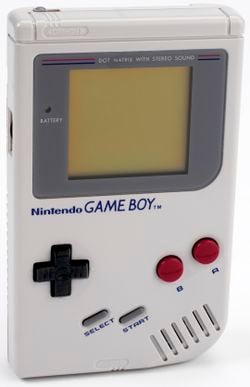
| |
| Generation | Fourth generation |
| Release date | |
| Discontinued | 2003[4] |
| Predecessor | Game & Watch |
| Successor | Virtual Boy Game Boy Color |
- “Now you're playing with power. Portable power.”
- —The Game Boy slogan
The Game Boy (rebranded the Hyundai Mini Comboy in South Korea) is Nintendo's second handheld console. It was released in Japan on April 21, 1989; in North America on July 31, 1989; in most of Europe on September 28, 1990; in Hungary in 1991; in South Korea on May 2, 1991; in South Africa in 1992; in Croatia, the Czech Republic, Slovakia, Slovenia, and Yugoslavia in 1994; and in Poland on November 14, 1994 (the latter simultaneously with the Nintendo Entertainment System and Super Nintendo Entertainment System).[1] It has had many games of the Super Mario franchise released for it and many appearances in the franchise itself. The Game Boy is one of the best-selling game systems of all time, selling around 64,420,000 units worldwide, and the console found enough success not to receive a successor until the Game Boy Color in 1998, and not to be discontinued until 2003. The Game Boy has 8-bit graphics, not unlike the Nintendo Entertainment System, but can display only up to four colors at once. Its codename is the Dot Matrix Game, referring to the dot-matrix display it had for its games, contrasting the preceding Game & Watch's pre-printed LCD display. The Game Boy has the ,
,
, and
buttons as well as
, giving it a similar control scheme to the Nintendo Entertainment System's.
In 1995, a new version of the Game Boy, as part of Nintendo's "Play It Loud!" campaign, was released. This version is exactly the same as the original; the only difference is that it was released in a wide variety of colors such as red, blue, green, and even clear. Game Boy and Game Boy Color games were also available on the Nintendo 3DS Virtual Console before it was discontinued in March 2023. In February 2023, they were added to the Nintendo Switch Online service, available in the Game Boy - Nintendo Switch Online application.
Hardware specifications[edit]
- CPU: Z80 8-bit CMOS
- CPU Speed: 4.19 Mhz
- RAM: 8 Kbyte
- Maximum Resolution: 160 x 144 pixels
- Colors: Grayscale (four shades of gray; olive green in some cases) (in Color, they get 32,768 colors + 56 colors maximum on screen)
- Maximum sprite size: 8 x 16 pixels
- Maximum number of sprites on screen: 40 sprites, 10 per line
- Minimum/Maximum cart size: 256 Kbit - 16 Mbit
- Sound: 4 Channel
Compatibility[edit]
The Game Boy is unique in that some games for the Game Boy Color are also playable on original Game Boy units; such games were released on black cartridges, such as Wario Land II and Game & Watch Gallery 3. Game Boy Color games released on clear cartridges, such as Super Mario Bros. Deluxe and Mario Tennis, cannot be played on original Game Boy units, and attempting to causes the game to display a message stating that it is playable only on the Game Boy Color.
| Example Cartridge | Usual Color | Game Boy mode | Compatible | |
|---|---|---|---|---|
| Original Game Boy cartridge | 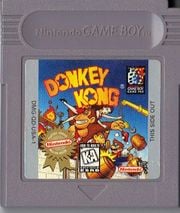
|
Gray | ||
| Game Boy Color cartridge (Black) | 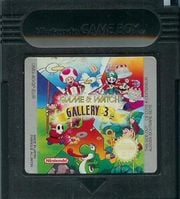
|
Black | ||
| Game Boy Color cartridge (Clear) | 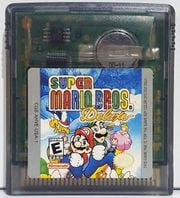
|
Clear |
Accessories[edit]
Game Link Cable[edit]
- NintendoWiki article: Game Link Cable
There is a Game Link Cable accessory that allows for two Game Boys to connect with each other. It is used by several Super Mario games, such as Dr. Mario and Super Mario Bros. Deluxe. A 4-player version of the accessory exists for games that can take advantage of this accessory. Not to be confused with Game Boy Advance's method of doing so. To communicate with later models, such as the Game Boy Pocket or Game Boy Color, a special adapter needs to be used (model MGB-004).
Game Boy Camera[edit]
- Main article: Game Boy Camera
This accessory transforms the Game Boy into a very primitive monochrome digital camera.
Game Boy Printer[edit]
- NintendoWiki article: Game Boy Printer
- Bulbapedia article: Game Boy Printer
This accessory allows the ability to make prints of images on special thermal paper. Game Boy Printer connects to the Game Boy via Game Link Cable. The main accessory to use this accessory, as well as the only cartridge for the original Game Boy models to use it that was related to the Super Mario franchise, was the Game Boy Camera. The only dedicated Super Mario games that used it, Super Mario Bros. Deluxe and Donkey Kong Country, were Game Boy Color games without support for older Game Boy models.
GB Memory Cartridge[edit]
- Main article: Nintendo Power (cartridge)
Only in Japan, the GB Memory Cartridge is a rewritable version of regular cartridges, through kiosks at retail stores between 1997-2007.
Remodels[edit]
Super Game Boy[edit]
- Main article: Super Game Boy
The Super Game Boy is not an actual system; rather, it is a Super Nintendo cartridge that one could insert Game Boy cartridges into, thus enabling people to play Game Boy games on their television screens through the Super Nintendo. Certain games have additional colors that can only be seen while played on a Super Game Boy. Donkey Kong has a special color palette designed for the Super Game Boy, as well as a special border designed to resemble the original arcade cabinet. Game Boy Color games with black cartridges can be played on the Super Game Boy. These features are not available on the 3DS versions due to using a Game Boy emulator rather then a SNES emulator.
Game Boy Pocket[edit]
- NintendoWiki article: Game Boy Pocket
The Game Boy Pocket is the second system of the Game Boy line. As the name implies, it is a pocket-sized Game Boy with its same features, and it was lighter in weight, with a clearer, more monochrome screen and a longer battery life. It requires two AAA batteries rather than four AA batteries in order to play games. The first release had no battery light indicator and it was rapidly replaced with a second release with the battery light due to customer complaints. The second release made its way into markets in several different colors (red, blue, green, yellow, black, etc.). It was released on July 21, 1996.[5]
Game Boy Light[edit]
- NintendoWiki article: Game Boy Light
The Game Boy Light is the third system in the Game Boy line. It was released only in Japan on April 14, 1998, since Nintendo was more focused on releasing the Game Boy Color in other regions.[citation needed] The system is slightly bigger than a Game Boy Pocket and came only in two colors, gold and silver. Its main function, as the name implies, is the ability to produce a blue-tinted backlight in order to play games in low light conditions. There were several special editions such as the Astro Boy edition.
It was the only Game Boy system to have a proper backlight until the release of the Game Boy Advance SP.
Appearances in the Super Mario franchise[edit]
Game Boy comics[edit]
In the Game Boy comics mini-series by Valiant, Game Boys acted as gateways between the Mushroom World and Earth.
Club Nintendo comics[edit]

The Club Nintendo comic "Wart steht unter Strom" is about Wart (actually Bowser erroneously labeled as "Wart") who is playing Game Boy. The power of the batteries expires, so Wart carelessly throws the batteries away. Mario reminds him that they should be properly disposed of in containers instead. One cover of Club Nintendo features artwork of Mario, Luigi, Princess Peach, and Bowser playing with Game Boys. It also featured Mario and Luigi playing together via the Game Link Cable on the editorial page.
Nintendo Adventure Books[edit]
In the Doors to Doom book from the Nintendo Adventure Books series, Mario and Luigi can encounter Wart, who is relaxing in his lair and playing a Game Boy, having mellowed out and become a skateboarder since his last encounter with the heroes.
Mario's Picross[edit]
In Mario's Picross, Level 1A of the Kinoko Course depicts a Game Boy.
Super Mario RPG: Legend of the Seven Stars[edit]
In Super Mario RPG: Legend of the Seven Stars, Mario is able to buy a game from a Game Boy Toad at the Mushroom Kingdom inn.
Luigi's Mansion[edit]
In Luigi's Mansion, there is a Boo called Game Boo.
WarioWare series[edit]
WarioWare, Inc.: Mega Microgame$![edit]
In WarioWare, Inc.: Mega Microgame$!, 9-Volt has a giant Game Boy in his house. There is also a microgame titled Game Boy in which the object is to insert a Game Pak into a Game Boy.
WarioWare: Smooth Moves[edit]
In WarioWare: Smooth Moves, a Game Boy appears in Level 2 of the microgame Sifty Character.
WarioWare Gold[edit]
In WarioWare Gold, a Game Boy appears as a souvenir. It is accompanied by the description, "Unlike Game & Watch, the Game Boy used an idea from Famicom: changing games by swapping cartridges. It also used batteries—extras were handy!"
WarioWare: Get It Together![edit]
In WarioWare: Get It Together!, a Game Boy poster can be seen in 9-Volt's bedroom. In his level, Nintendo Classics, the boss that appears in the intermission before the boss microgame carries a shield with a Game Boy design.
Nintendo Puzzle Collection[edit]
The Game Boy's startup sound can be heard in Nintendo Puzzle Collection while playing Yoshi's Cookie. It is heard when a lightbulb appears over Mario's head.
Paper Mario: The Thousand-Year Door[edit]
In Paper Mario: The Thousand-Year Door, there is an oversized Game Boy as the scoreboard in the Pianta Parlor.
NES Remix series[edit]
In NES Remix and NES Remix 2, Some Remix and Bonus stages have the graphics switch between normal graphics and a filter with white background and black sprites, similar to the Game Boy. The sound will also be muffled when the filter is applied, similar to the Game Boy sound as well.
Super Smash Bros. series[edit]
A stage that takes place in a Game Boy system, Dream Land GB (based on Kirby's Dream Land), appears in Super Smash Bros. for Nintendo 3DS and Super Smash Bros. Ultimate. Additionally, during the Classic mode credits minigame, hitting the Nintendo logo towards the end plays the Game Boy start-up sound.
Super Mario Odyssey[edit]
Though the Game Boy itself does not appear in Super Mario Odyssey, one of the filters that is available for use in Snapshot Mode is the graphics style of the Game Boy.
Gallery[edit]
System gallery[edit]
Pocket Camera played on the Game Boy Pocket
Game Boy Nintendo Player's Guide
Game gallery[edit]
Miscellaneous[edit]
Photo of the "Ultra Machine SP" exhibit at the Nintendo Museum
References[edit]
- ^ a b c d e f g h Joshua Rogers (December 26, 2020). World of Nintendo: Exploring Nintendo in (Eastern) Europe. PAX (via YouTube) (English). Retrieved June 5, 2024. (Archived June 5, 2024, 20:16:14 UTC via Wayback Machine.)
- ^ [좌충우돌 4월 21일 - 게임보이, 세상에 나오다]. This is Game (Korean). Retrieved April 22, 2024.
- ^ Rogers, Joshua Alexander (April 16, 2020). Video Games around the World. LinkedIn. (Archived September 25, 2022, 15:36:58 UTC via Wayback Machine.)
- ^ Consolidated Sales Transition by Region (PDF). Nintendo.com. Retrieved March 5, 2020.
- ^ Minotti, Mike (April 21, 2014). 25 years of the Game Boy: A timeline of the systems, accessories, and games. VentureBeat. Retrieved March 5, 2020.
External links[edit]
- Nintendo Gateway System (Wikipedia) – Versions of Nintendo systems, including the Game Boy, specialized for airlines and hotels
| Game Boy games | |
|---|---|
| Super Mario franchise | Alleyway (1989) • Baseball (1989) • Super Mario Land (1989) • Golf (1989) • Dr. Mario (1990) • Super Mario Land 2: 6 Golden Coins (1992) • Donkey Kong (1994) • Mario's Picross (1995) • Picross 2 (1996) |
| Donkey Kong franchise | Donkey Kong (1994) • Donkey Kong Land (1995) • Donkey Kong Land 2 (1996) • Donkey Kong Land III (1997) |
| Yoshi franchise | Yoshi (1991) • Yoshi's Cookie (1992) • Tetris Attack (1996) |
| Wario franchise | Wario Land: Super Mario Land 3 (1994) • Wario Blast: Featuring Bomberman! (1994) • Wario Land II (1998) |
| Miscellaneous | Tetris (1989) • The Legend of Zelda: Link's Awakening (1993) • Game & Watch Gallery (1997) • Game & Watch Gallery 2 (1997) |
| Video game systems and add-ons | |
|---|---|
| Nintendo home consoles | Family Computer/Nintendo Entertainment System (Family BASIC, Family Computer Disk System) • Super Famicom/Super Nintendo Entertainment System (Satellaview, Super Game Boy) • Nintendo 64 (Nintendo 64DD) • Nintendo GameCube (Game Boy Player) • Wii (Virtual Console, WiiWare) • Wii U (Virtual Console) • Nintendo Switch |
| Nintendo handhelds | Game & Watch • Game Boy • Virtual Boy • Game Boy Color • Game Boy Advance • Nintendo DS (Nintendo DSi, DSiWare) • Nintendo 3DS (Virtual Console) • Nintendo Switch |
| Other | MS-DOS • VS. System • Nintendo PlayChoice-10 • Nintendo Super System • Nelsonic Game Watch • Super Mario Bros. Watch • Gamewatch Boy • Philips CD-i • Mini Classics • Triforce • Visteon Dockable Entertainment System • Classics • LodgeNet • Nintendo Sound Clock: Alarmo |
